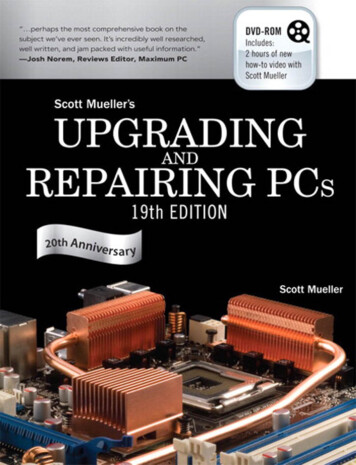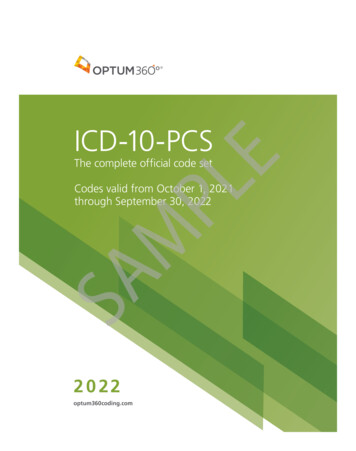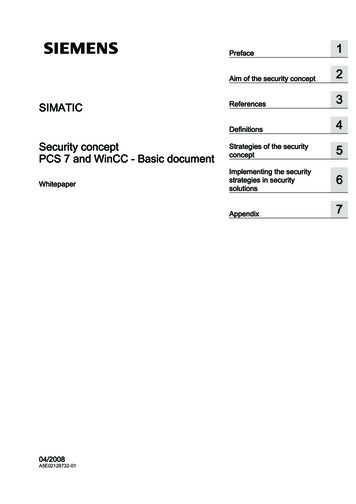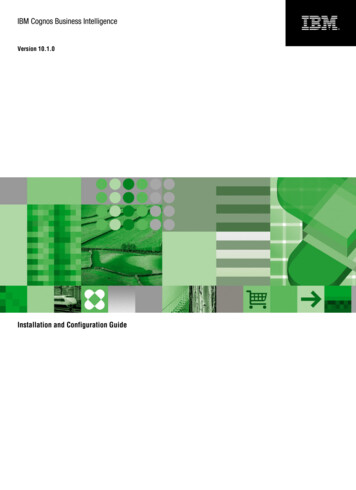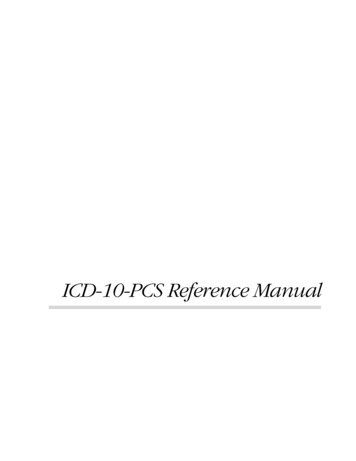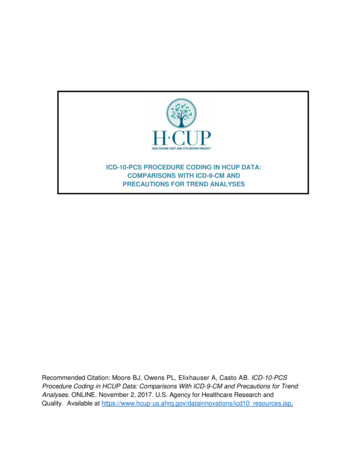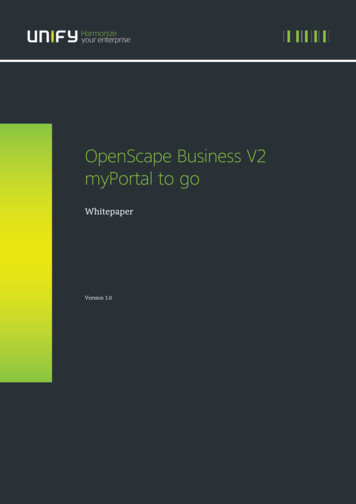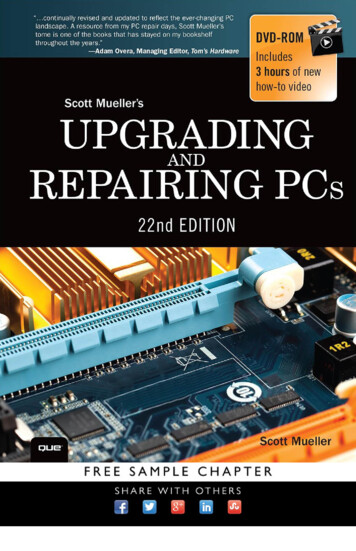
Transcription
Contents at a GlanceIntroduction11 Development of the PC 52 PC Components, Features, andSystem Design 213 Processor Types and Specifications 334 Motherboards and Buses 165UPGRADINGANDREPAIRING PCs22nd Edition5 BIOS2816 Memory3557 The ATA/IDE Interface 4098 Magnetic Storage4759 Flash and Removable Storage 54710 Optical Storage56911 Video Hardware65712 Audio Hardware73313 External I/O Interfaces 75714 Input Devices79515 Internet Connectivity83116 Local Area Networking 85317 Power Supplies90318 Building or Upgrading Systems 99319 PC Diagnostics, Testing, andMaintenance 1039IndexScott M. Mueller800 East 96th Street,Indianapolis, Indiana 46240 USA1101
Upgrading and Repairing PCs, 22nd EditionCopyright 2015 by Pearson Education, Inc.All rights reserved. No part of this book shall be reproduced, stored in a retrievalsystem, or transmitted by any means, electronic, mechanical, photocopying,recording, or otherwise, without written permission from the publisher. No patent liability is assumed with respect to the use of the information containedherein. Although every precaution has been taken in the preparation of this book,the publisher and author assume no responsibility for errors or omissions. Nor isany liability assumed for damages resulting from the use of the information contained herein.ISBN-13: 978-0-7897-5610-7ISBN-10: 0-7897-5610-2Library of Congress Control Number: 2015938404Printed in the United States of AmericaEditor-in-ChiefGreg WiegandExecutive EditorRick KughenDevelopment EditorTodd BrakkeManaging EditorSandra SchroederProject EditorMandie FrankCopy EditorMegan Wade-TaxterIndexerErika MillenFirst Printing: June 2015ProofreaderTrademarksTechnical EditorAll terms mentioned in this book that are known to be trademarks or servicemarks have been appropriately capitalized. Que Publishing cannot attest to theaccuracy of this information. Use of a term in this book should not be regarded asaffecting the validity of any trademark or service mark.Warning and DisclaimerEvery effort has been made to make this book as complete and as accurate as possible, but no warranty or fitness is implied. The information provided is on an“as is” basis. The author and the publisher shall have neither liability nor responsibility to any person or entity with respect to any loss or damages arising fromthe information contained in this book or from the use of the DVD or programsaccompanying it.Special SalesFor information about buying this title in bulk quantities, or for special salesopportunities (which may include electronic versions; custom cover designs; andcontent particular to your business, training goals, marketing focus, or brandinginterests), please contact our corporate sales department at corpsales@pearsoned.com or (800) 382-3419.For government sales inquiries, please contact governmentsales@pearsoned.com.For questions about sales outside the U.S., please contactinternational@pearsoned.com.Debbie WilliamsKaren WeinsteinEditorial AssistantKristen WattersonMedia ProducerDan ScherfDesignerMark ShirarCompositorNonie Ratcliff
ContentsIntroduction11 Development of the PC5Computer History: Before PersonalComputers 5Timeline 5Electronic Computers 10Modern Computers 11From Tubes to Transistors 11Integrated Circuits 14History of the PC 15Birth of the Personal Computer 15The IBM Personal Computer 16The PC Industry 34 Years Later 172 PC Components, Features, andSystem Design 21What Is a PC? 21Who Controls PC Software? 23Who Controls PC Hardware? 26White-Box Systems 28System Types 29System Components 303 Processor Types andSpecifications 33Microprocessor History 33The First Microprocessor 33PC Processor Evolution 3616-Bit to 64-Bit Architecture Evolution 39Processor Specifications 40Data I/O Bus 48Address Bus 48Internal Registers (Internal Data Bus) 49Processor Modes 49Processor Benchmarks 54Comparing Processor Performance 55Cache Memory 58Processor Features 65System Management Mode 65Superscalar Execution 66MMX Technology 67Dynamic Execution 69Dual Independent Bus Architecture 70HT Technology (Hyperthreading) 70Multicore Technology 72Hardware-Assisted VirtualizationSupport 73Processor Manufacturing 74PGA Chip Packaging 78Single Edge Contact and Single EdgeProcessor Packaging 80Processor Socket and Slot Types 81Socket LGA775 84Socket LGA1156 85Socket LGA1366 86Socket LGA1155 87Socket LGA2011 87Socket LGA1150 89Socket AM2/AM2 /AM3/AM3 89Socket F (1207FX) 91Socket FM1 92Socket FM2 92Socket FM2 92Socket AM1 (Socket FS1B) 92CPU Operating Voltages 93Math Coprocessors (Floating-Point Units) 94Processor Bugs and Steppings 94Processor Code Names 95P1 (086) Processors 95P2 (286) Processors 97P3 (386) Processors 98P4 (486) Processors 99P5 (586) Processors 100AMD-K5 102Intel P6 (686) Processors 103Pentium Pro Processors 103Pentium II Processors 104Pentium III 106Celeron 107Intel Pentium 4 and Extreme EditionProcessors 108Intel Pentium D and Pentium ExtremeEdition 110Intel Core Processors 112Intel Core 2 Family 112Intel (Nehalem) Core i Processors 116AMD K6 Processors 121AMD K7 Processors 122AMD Athlon 122AMD Duron 123AMD Athlon XP 124Athlon MP 124
ivContentsThis is the Chapter TitleAMD K8 Processors 124AMD Athlon 64 and 64 FX 124AMD Sempron 128AMD Athlon X2, 64 X2, and 64 FX 128AMD K10 Processors (Phenom, Phenom II,Athlon II, Athlon X2, Sempron) 130AMD Bulldozer, Piledriver, Steamroller, andExcavator FX Processors 134AMD Fusion/HSA APUs 137Processor Upgrades 139Overclocking 142Quartz Crystals 142Modern PC Clocks 145Overclocking Tips 147Unlocking Cores 148Bus Speeds and Multipliers 149Processor Cooling 152Heatsinks 152Liquid Cooling 158Thermally Advantaged Chassis 159Processor Troubleshooting Techniques 1614 Motherboards and Buses165Motherboard Form Factors 165Obsolete Form Factors 166ATX and Other Modern FormFactors 177Processor Sockets/Slots 189Chipsets 192Chipset Evolution 193Intel Chipsets 195Intel Chipset Model Numbers 195Intel Integrated GraphicsArchitecture 197AMD Integrated GraphicsArchitecture 197Traditional North/southbridgeArchitecture 197Hub Architecture 199HyperTransport and Other Processor/Chipset Interconnects 201Intel’s Early 386/486 Chipsets 201Fifth-Generation (P5 Pentium Class)Chipsets 202Sixth-Generation (P6 Pentium Pro/II/III Class)Chipsets 203Seventh/Eighth-Generation (Pentium 4/D,Core 2, and Core i) Chipsets 207Intel 915 Family 215Intel 925X Family 215Intel 945 Express Family 216Intel 955X and 975X Family 217Intel 96x Series 217Intel 3x and 4x Series Chipsets 218Intel 5x Series Chipsets 220Intel 6x Series Chipsets 224Intel 7x Series Chipsets 225Intel 8x Series Chipsets 227Intel 9x Series Chipsets 229Third-Party Chipsets for Intel Processors 231SiS Chipsets 231ULi Electronics Chipsets 231ATI Chipsets 231VIA Chipsets 232NVIDIA Chipsets for Intel Processors 232Chipsets for AMD Processors 232AMD Athlon Chipsets 233AMD Athlon 64 Chipsets 234AMD 8000 (8151) Chipset 234AMD (Formerly ATI) Chipsets for Athlon64, Sempron, Phenom 235Third-Party Chipsets for AMDProcessors 242VIA Chipsets 242SiS Chipsets 242NVIDIA Chipsets 243Super I/O Chips 244Motherboard Connectors 244System Bus Types, Functions, andFeatures 255The Processor Bus (FSB) 261Types of I/O Buses 262The ISA Bus 262The Micro Channel Bus 262The EISA Bus 263Local Buses (VESA, PCI, PCI Express,AGP) 263System Resources 270Interrupts 271DMA Channels 276I/O Port Addresses 276Motherboard Selection Criteria (KnowingWhat to Look For) 278Chipset Documentation 2795 BIOS281BIOS Basics 281Motherboard ROM BIOS 285ROM Hardware 285ROM Shadowing 287ROM Chip Types 287ROM BIOS Manufacturers 291BIOS Hardware/Software 292Upgrading the BIOS 292Where to Get Your BIOS Update 293Determining Your BIOS Version 293
This is the Current C–Head at the BOTTOM of the PageBacking Up Your BIOS 293Backing Up Your BIOS Setup (CMOS RAM)Settings 294Upgrading a Flash BIOS 295Motherboard CMOS RAM Addresses 303Preboot Environment 305Unified Extensible Firmware Interface 307UEFI and BIOS Limitations 307UEFI Support 309BIOS Setup 309Running or Accessing the BIOS SetupProgram 310BIOS Setup Menus 310Maintenance Menu 311Main Menu 313Exit Menu 345AMD-Specific BIOS Settings 346PnP BIOS 347PnP Device IDs 347ACPI 347BIOS/MBR Error Messages 348BIOS Boot Error Messages 349MBR Boot Error Messages 3526 Memory355Memory Basics 355ROM 357DRAM 357Cache Memory: SRAM 359Memory Standards 361Speed and Performance 362Fast Page Mode DRAM 365Extended Data Out RAM 366SDRAM 367DDR SDRAM 368DDR2 SDRAM 370DDR3 SDRAM 372DDR4 SDRAM 374RDRAM 375Memory Modules 375Registered Modules 382SDR DIMM Details 383DDR DIMM Details 384DDR2 DIMM Details 384DDR3 DIMM Details 384DDR4 DIMM Details 384Determining a Memory Module’s Size andFeatures 385Memory Banks 387Memory Module Speed 388Parity and ECC 388Parity Checking 390How Parity Checking Works 391ECC 391vContentsRAM Upgrades 392Upgrade Options and Strategies 393Purchasing Memory 395Replacing Modules with Higher-CapacityVersions 397Installing Memory Modules 397Troubleshooting Memory 399Memory Defect Isolation Procedures 403The System Logical Memory Layout 4057 The ATA/IDE Interface409An Overview of the IDE Interface 409Precursors to IDE 409IDE Origins 410Origins of ATA 411ATA Standards 412ATA-1 (ATA Interface for DiskDrives) 414ATA-2 (ATA Interface withExtensions-2) 415ATA-3 (ATA Interface-3) 415ATA/ATAPI-4 (ATA with Packet InterfaceExtension-4) 416ATA/ATAPI-5 (ATA with PacketInterface-5) 417ATA/ATAPI-6 (ATA with PacketInterface-6) 417ATA/ATAPI-7 (ATA with PacketInterface-7) 418ATA/ATAPI-8 419PATA 419PATA I/O Connector 419PATA I/O Cable 423Longer or Rounded Cables 425PATA Signals 425PATA Dual-Drive Configurations 426PATA PIO Transfer Modes 429PATA DMA Transfer Modes 429SATA 431SATA Standards and Performance 431SATA Express 432SATA Cables and Connectors 434eSATA 439SATA Configuration 443Advanced Host Controller Interface 444Non-Volatile Memory Express 445SATA Transfer Modes 445ATA Features 446ATA Commands 446ATA Security Mode 447Host Protected Area 448ATAPI 449ATA Drive Capacity Limitations 450
viContentsThis is the Chapter TitlePrefixes for Decimal and BinaryMultiples 451BIOS Limitations 451CHS Versus LBA 452CHS/LBA and LBA/CHS Conversions 453BIOS Commands Versus ATACommands 454CHS Limitations (the 528MB Barrier) 455CHS Translation (Breaking the 528MBBarrier) 457The 2.1GB and 4.2GB Barriers 459LBA-Assist Translation 462The 8.4GB Barrier 465The 137GB Barrier and Beyond 466Operating System and Other SoftwareLimitations 468GPT and the 2.2TB Barrier 470PATA/SATA RAID 471Software RAID 4748 Magnetic Storage475Magnetic Storage 475History of Magnetic Storage 475How Magnetic Fields Are Used to StoreData 476Read/Write Head Designs 479Ferrite 480Metal-In-Gap 480Thin-Film 480Magneto-Resistive Heads 481Giant Magneto-Resistive Heads 482Head Sliders 483Data-Encoding Schemes 486Frequency Modulation Encoding 487Modified FM Encoding 487Run Length Limited Encoding 488Encoding Scheme Comparisons 489Partial-Response, Maximum-LikelihoodDecoders 490Capacity Measurements 491Areal Density 492Perpendicular Magnetic Recording 495Helium-Filled Drives 497Shingled Magnetic Recording 497Definition of a Hard Disk 498Hard Drive Advancements 499Form Factors 5005 1/4-Inch Drive 5023 1/2-Inch Drive 5022 1/2-Inch Drive 5021.8-Inch Drive 5031-Inch Drives 503HDD Operation 503Data Recovery Options 505The Ultimate HDD Analogy 506Tracks and Sectors 507ECC 510Disk Formatting 515Basic HDD Components 521Hard Disk Platters (Disks) 522Recording Media 522Read/Write Heads 524Head Actuator Mechanisms 526Air Filters 532Hard Disk Temperature Acclimation 534Spindle Motors 534Logic Boards 535Cables and Connectors 536Configuration Items 536Hard Disk Features 536Capacity 537Performance 538Reliability 5439 Flash and RemovableStorage 547Alternative Storage Devices 547Flash Memory Devices 547CompactFlash, XQD, and CFast 549SmartMedia 551MultiMediaCard 551SecureDigital 552Sony Memory Stick 552ATA Flash PC Card 553Card-Picture Card 553Solid-State Drives 553Virtual SSD (RAMdisk) 554Flash-Based SSDs 554USB Flash Drives 558Comparing Flash Memory Devices 559SD Cards Speed Class and UHS Speed ClassMarkings 561File Systems Used by Flash Memory 563Flash Card Readers 563Card Readers 563ReadyBoost Support 564Cloud-Based Storage 565Floppy Disk Drives 566Tape Drives 56710 Optical Storage569Optical Technology 569CD-Based Optical Technology 570CDs: A Brief History 570CD Construction and Technology 571
This is the Current C–Head at the BOTTOM of the PageMass-Producing CDs 571Writable CDs 583MultiRead Specifications 590MultiPlay and MultiAudio 592DVD 592DVD History 593DVD Construction and Technology 593DVD Tracks and Sectors 595Handling DVD Errors 599DVD Capacity (Sides and Layers) 601Data Encoding on the DVD Disc 604Recordable DVD Standards 604Multiformat Rewritable DVD Drives 612BD 613HD-DVD 616Optical Disc Formats 616CD Formats 616DVD Formats and Standards 625Optical Disc File Systems 628Ripping/Copying Discs 634”For Music Use Only” CD-R/RWDiscs 635CD Copy Protection 635CD Digital Rights Management 636DVD and Blu-ray Copy Protection 636Optical Drive PerformanceSpecifications 640CD Data Transfer Rate 640CD Drive Speed 640DVD Drive Speed 641BD Drive Speed 644Access Time 645Buffer/Cache 646Direct Memory Access andUltra-DMA 646Interface 646Loading Mechanism 647Other Drive Features 648How to Reliably Record Optical Discs 648Bootable Optical Discs—El Torito 649LightScribe and LabelFlash 649Troubleshooting Optical Drives 649Caring for Optical Media 653Updating the Firmware in an OpticalDrive 65411 Video Hardware657Display Adapters and Monitors 657Video Display Adapters 658Video Adapter Types 658Integrated Video/MotherboardChipsets 659CPUs with Integrated Video 663ContentsviiIntel Processors with IntegratedGraphics 664AMD Desktop APUs 667Video Adapter Components 671Identifying the Video and SystemChipsets 673Video RAM 674The DAC 678Video Display Interfaces 678The System Interface 678The Display Interface 679TV Display Interfaces 6953D Graphics Accelerators 696How 3D Accelerators Work 697APIs 700Dual-GPU Scene Rendering 704Monitors 707Display Specifications 707LCD and LED Technology 716Touchscreens 719Plasma Display Technology 720LCD and DLP Projectors 721Using Multiple Monitors 722Dualview 722Homogeneous Adapters 723Heterogeneous Adapters 723Choosing the Best Display Hardware for aParticular Task 723Video Troubleshooting andMaintenance 724Troubleshooting Video Cards andDrivers 725Video Drivers 727Maintaining Monitors 728Testing Monitors 728Adjusting Monitors 729Bad Pixels 730Troubleshooting Monitors 730Repairing Monitors 73112 Audio Hardware733Audio Hardware Concepts and Terms 734The Nature of Sound 734Evaluating the Quality of Your AudioHardware 734Sampling 735Early PC Sound Cards 736Limitations of Sound Blaster ProCompatibility 736Microsoft Windows and AudioSupport 736DirectX and Audio SupportHardware 737
viiiContentsThis is the Chapter TitleCore Audio APIs for Windows 7373D Gaming Audio Standards 738Legacy Audio Support ThroughVirtualization 740Audio Hardware Features 740Basic Connectors 740Audio Signal Processing Methods 743Advanced Audio Features 743Volume Control 745MIDI Support Features 745Data Compression 746Sound Drivers 747Sound Cards for Sound Producers 748Motherboard Chipsets with IntegratedAudio 748Intel “Azalia” HD Audio 749Troubleshooting PC Audio Problems 749Sound Card and Onboard AudioProblems 749Speakers 753Speaker Selection Criteria 753Theater and Surround SoundConsiderations 754Microphones 75513 External I/O Interfaces757Introduction to Input/Output Ports 757Serial Versus Parallel 757Universal Serial Bus 758IEEE 1394 (FireWire or i.LINK) 775Hot-Plugging (and Unplugging) 779Thunderbolt Technology 782Low-Speed External Connections 784Serial Ports 784Parallel Ports 78914 Input Devices795Keyboards 795Enhanced 101-Key Keyboard 795103/104-Key Windows Keyboard 796Keyboard Technology 798Keyswitch Design 798The Keyboard Interface 804Typematic Functions 805Keyboard Scan Codes 806International Keyboard Layouts 807Keyboard/Mouse InterfaceConnectors 808USB Keyboards 810Keyboards with Special Features 811Keyboard Troubleshooting and Repair 811Cleaning a Keyboard 812Keyboard Recommendations 813Pointing Devices 814Mouse Sensitivity 815Ball-Type Mice 815Optical Mice 815Pointing Device Interface Types 817Scroll Wheels 819Mouse Troubleshooting 821Cleaning Your Mouse 821Alternative Pointing Devices 821Touchscreen Technology 826Wireless Input Devices 827Power Management Features of WirelessInput Devices 828Supporting Multiple Devices with a SingleTransceiver 829Troubleshooting Wireless InputDevices 82915 Internet Connectivity831Internet Connectivity Trends 831Broadband Internet Access Types 832Cable Internet 832Digital Subscriber Line 836Wireless Broadband 840Cellular Broadband 3G and 4GServices 840Satellite Broadband 841ISDN 844Leased Lines 845Comparing High-Speed InternetAccess 846Dial-Up Modems 847Internet Connection Security 848Having a Backup Plan in Case of ServiceInterruptions 849Sharing Your Internet Connection 850Routers for Internet Sharing 850Modem/Router Status LEDs 85116 Local Area Networking853Defining a Network 853Types of Networks 854Requirements for a Network 855Client/Server Versus Peer Networks 855Client/Server Networks 856Peer-to-Peer Networks 857Comparing Client/Server and Peer-to-PeerNetworks 857Network Architecture Overview 858Wired Ethernet 860Wireless Ethernet 862Bluetooth 868
This is the Current C–Head at the BOTTOM of the PageHardware Elements of Your Network 869NICs for Wired Ethernet Networks 869Network Cables for Wired Ethernet 871Wired Network Topologies 880Switches for Ethernet Networks 883Wireless Ethernet Hardware 887Network Protocols 892IP and TCP/IP 892IPX and NetBEUI 893Other Home Networking Solutions 894HomePNA 894HomeGrid Forum and G.hnNetworking 895Power Line Networking 895Putting Your Network Together 897Network Adapters 898Cables and Connections BetweenComputers 899Switch/Access Point 89917 Power Supplies903The Power Supply 903Primary Function and Operation 903Voltage Rails 904The Power Good Signal 906Power Supply Form Factors 907Modern Form Factors 910Power Switches 925ATX and Newer 925PC/XT/AT and LPX Power Switches 927Motherboard Power Connectors 928AT/LPX Power Supply Connectors 929ATX and ATX12V Motherboard PowerConnectors 931Backward and Forward Compatibility 944Dell Proprietary (Nonstandard) ATXDesign 946Additional Power Connectors 946Peripheral Power Connectors 946Floppy (Berg) Power Connectors 947Serial ATA Power Connectors 948PCI Express Auxiliary Graphics PowerConnectors 949Power Supply Specifications 953Power Supply Loading 953Power Supply Ratings 955Other Power Supply Specifications 956Power Factor Correction 958SLI-Ready and CrossFire/CrossFireXCertifications 960Safety Certifications 960Power-Use Calculations 961ContentsixPower Savings 96380 Plus 963ENERGY STAR 965Advanced Configuration and PowerInterface 966Power Cycling 968Power Supply Troubleshooting 972Overloaded Power Supplies 973Inadequate Cooling 973Using Digital Multimeters 974Specialized Test Equipment 977Power Supply Recommendations 980Modular Cables 981Sources for Replacement PowerSupplies 982Power-Protection Systems 982Surge Suppressors (Protectors) 984Network and Phone Line SurgeProtectors 984Line Conditioners 985Backup Power 985Real-Time Clock/Nonvolatile RAM (CMOSRAM) Batteries 988Modern CMOS Batteries 989Obsolete or Unique CMOS Batteries 990CMOS Battery Troubleshooting 99118 Building or UpgradingSystems 993System Components 993Before You Start: How to Decide What toBuild 995Case and Power Supply 997Processor 998Motherboard 999Memory 1001I/O Ports 1001Hard Disk/Solid-State Drives 1003Removable Storage 1003Input Devices 1004Video Card and Display 1004Audio Hardware 1005Accessories 1005Hardware and Software Resources 1006System Assembly and Disassembly 1007Assembly Preparation 1007Installing the CPU and Heatsink 1011Installing Memory Modules 1017Mounting the New Motherboard inthe Case 1018Preparing a Modular Power Supply 1023Connecting the Power Supply 1023
xContentsThis is the Chapter TitleConnecting I/O and Other Cables to theMotherboard 1026Installing the Drives 1027Installing a Video Card 1031Installing Additional ExpansionCards 1033Replacing the Cover and ConnectingExternal Cables 1033System Startup 1033Installing the OS 1035Troubleshooting New Installations 103719 PC Diagnostics, Testing, andMaintenance 1039PC Diagnostics 1039Diagnostics Software 1039The POST 1040Insyde BIOS Diagnostic and BeepCodes 1053Peripheral Diagnostics 1053Operating System Diagnostics 1053Commercial Diagnostics Software 1054Free/User-Supported Diagnostics 1055The Boot Process 1055The Hardware Boot Process: OperatingSystem Independent 1056The DOS Boot Process 1061The Windows 9x/Me Boot Process 1061Windows 2000/XP Startup 1061Windows Vista/7 Startup 1062Windows 8.1/10 Startup 1063PC Maintenance Tools 1063Hand Tools 1064Safety 1068Test Equipment 1069Special Tools for the Enthusiast 1074Preventive Maintenance 1075Active Preventive MaintenanceProcedures 1076Passive Preventive MaintenanceProcedures 1081Troubleshooting Tips and Techniques 1085Repair or Replace? 1086Basic Troubleshooting Steps 1086Troubleshooting by Replacing Parts 1087Troubleshooting by the BootstrapApproach 1087Problems During the POST 1089Problems Running Software 1089Problems with Adapter Cards 1089Top Troubleshooting Problems 1090Index1101
Accessing the Online Media Included withthis BookDon’t forget about the free bonus content available online! You’ll find a cache of helpful materialto go along with this book, including 2 hours of video, newly recorded for the 22nd edition. You’llalso find complete PDF copies of the 19th and 20th editions, as well as many pages of valuable reference material that is particularly useful for those maintaining legacy equipment.Register this eBook to unlock the companion files that are included in the Print edition DVD. Follow the steps below:1. Go to quepublishng.com/register and log in or create a new account.2. Enter the ISBN: 97801340577433. Enter the following code when prompted: URPCSDVD22E4. Click on the “Access Bonus Content” link in the Registered Products section of youraccount page, to be taken to the page where your content is available.The video files will play in your browser. Click the links to the 19th and 20th edition PDFs, andother materials to view them, or right-click and choose to save the file to your computer.
About the AuthorsScott Mueller is the president of Mueller Technical Research (MTR), an international researchand corporate training firm. Since 1982, MTR has produced the industry’s most in-depth, accurate, and effective seminars, books, articles, videos, and FAQs covering PC hardware and datarecovery. MTR maintains a client list that includes Fortune 500 companies, U.S. and foreign governments, major software and hardware corporations, as well as PC enthusiasts and entrepreneurs.Scott’s seminars have been presented to several thousands of PC support professionals throughoutthe world.Scott personally teaches seminars nationwide covering all aspects of PC hardware (includingtroubleshooting, maintenance, repair, and upgrade), A Certification, and data recovery/forensics.He has a knack for making technical topics not only understandable, but entertaining; his classesare never boring! If you have ten or more people to train, Scott can design and present a customseminar for your organization.Although he has taught classes virtually nonstop since 1982, Scott is best known as the authorof the longest-running, most popular, and most comprehensive PC hardware book in the world,Upgrading and Repairing PCs, which has become the core of an entire series of books, includingUpgrading and Repairing PCs, Upgrading and Repairing Laptops, and Upgrading and Repairing Windows.Scott’s premiere work, Upgrading and Repairing PCs, has sold more than two million copies,making it by far the most popular and longest-running PC hardware book on the market today.Scott has been featured in Forbes magazine and has written several articles for PC World magazine,Maximum PC magazine, the Scott Mueller Forum, various computer and automotive newsletters,and the Upgrading and Repairing PCs website.Contact MTR directly if you have a unique book, article, or video project in mind or if you wantScott to conduct a custom PC troubleshooting, repair, maintenance, upgrade, or data-recoveryseminar tailored for your organization:Mueller Technical ResearchWeb:www.muellertech.comEmail: info@muellertech.comForum: www.forum.scottmueller.comScott has a forum exclusively for his readers at www.forum.scottmueller.com. Anybody can viewthe forum, but posting is available only to registered members.If you have suggestions or comments about the book or new book or article topics you would liketo see covered, send them to info@muellertech.com.
This is the Current C–Head at the BOTTOM of the AboutPage the AuthorsxiiiMark Edward Soper has helped users deal with problems with computers, digital cameras, andother personal tech devices for more than 30 years. He is the author of PC and Gadgets Help Deskin a Book, author of Easy Windows 10, as well as more than two dozen other books on Windows,digital imaging, networking, broadband Internet, CompTIA A Certification, and computertroubleshooting and upgrading. With this level of experience, combined with years of teachingtechnical classes, Mark is experienced at helping readers understand and use creative solutions toconnectivity, configuration issues, data recovery, and other types of problems that can beset usersof personal technology.
We Want to Hear from You!As the reader of this book, you are our most important critic and commentator. We value youropinion and want to know what we’re doing right, what we could do better, what areas you’d liketo see us publish in, and any other words of wisdom you’re willing to pass our way.We welcome your comments. You can email or write to let us know what you did or didn’t likeabout this book—as well as what we can do to make our books better.Please note that we cannot help you with technical problems related to the topic of this book.When you write, please be sure to include this book’s title and author as well as your name andemail address. We will carefully review your comments and share them with the author and editors who worked on the book.Email:feedback@quepublishing.comMail:Que PublishingATTN: Reader Feedback800 East 96th StreetIndianapolis, IN 46240 USAReader ServicesVisit our website and register this book at quepublishing.com/register for convenient access to anyupdates, downloads, or errata that might be available for this book.
IntroductionWelcome to Upgrading and Repairing PCs, 22nd Edition. Since debuting as the first book of its kindon the market in 1988, no other book on PC hardware has matched the depth and quality of theinformation found in this tome. This edition continues Upgrading and Repairing PCs’ role as notonly the best-selling book of its type, but also the most comprehensive and complete PC hardwarereference available. This book examines PCs in depth, outlines the differences among them, andpresents options for configuring each system.The 22nd edition of Upgrading and Repairing PCs provides you with the in-depth knowledge you needto work with the most recent systems and components and gives you an unexcelled resource forunderstanding older systems. As with previous editions, we worked to make this book keep pace withthe rapid changes in the PC industry so that it continues to be the most accurate, complete, andin-depth book of its kind on the market today.I wrote this book for all PC enthusiasts who want to know everything about their PCs: how theyoriginated; how they’ve evolved; how to upgrade, troubleshoot, and repair them; and everything inbetween. This book covers the full gamut of PC-compatible systems, from the oldest 8-bit machinesto the latest high-end, 64-bit multicore processors and systems. If you need to know everythingabout PC hardware from the original to the latest technology on the market today, this book and theaccompanying information-packed disc is definitely for you.Upgrading and Repairing PCs also doesn’t ignore the less glamorous PC components. Every part ofyour PC plays a critical role in its stability and performance. Over the course of this book, you’ll findout exactly why your motherboard’s chipset might just be the most important part of your PC andwhat can go wrong when you settle for a run-of-the-mill power supply that can’t get enough juiceto that monster graphics card you just bought. You’ll also find in-depth coverage of technologiessuch as the latest Intel Haswell processors (and the Haswell Refresh!), forthcoming Intel Broadwelldesktop processors and AMD Kaveri APUs (and the latest about the graphics built into Intel and AMDprocessors); easy-to-use software to overclock your processor; the latest Intel and AMD chipsets; thelatest BIOS settings for new processors; how helium-filled hard disks and shingled magnetic recordingare leading to huge new hard disk capacities; the latest CFast and XQD flash memory cards; thenewest high-performance graphics cards based on AMD and NVIDIA GPUs for the fastest 3D gaming;the latest developments in OpenGL, OpenCL, and DirectX 3D APIs; how AMD’s Mantle improves3D gaming; USB charge while sleeping support and the new USB 3.1 interface; SATAExpress, mSATA,and M.2 interfaces; the latest satellite Internet speed boosts; choosing the right keyswitches for highperformance gaming or data entry keyboards; new HomeGrid and G.hn home network standards; andmore—it’s all in here, right down to the guts-level analysis of every port on the back of or inside yoursystem.
2IntroductionBook ObjectivesUpgrading and Repairing PCs focuses on several objectives. The primary objective is to help you learnhow to maintain, upgrade, and troubleshoot your PC system. To that end, Upgrading and
Every effort has been made to make this book as complete and as accurate as pos-sible, but no warranty or fitness is implied. The information provided is on an . The IBM Personal Computer 16 The PC Industry 34 Years Later 17 2 PC Components, Features, and . BIOS Hardware/Software 292 Upgrading the BIOS 292 Where to Get Your BIOS Update 293
